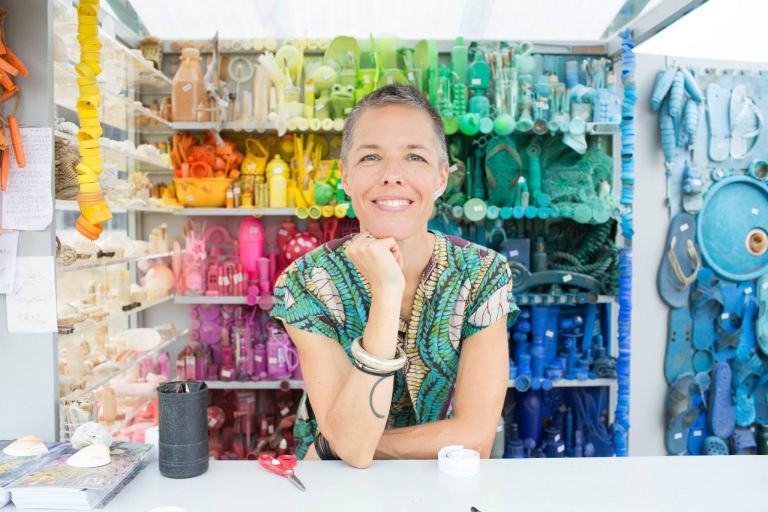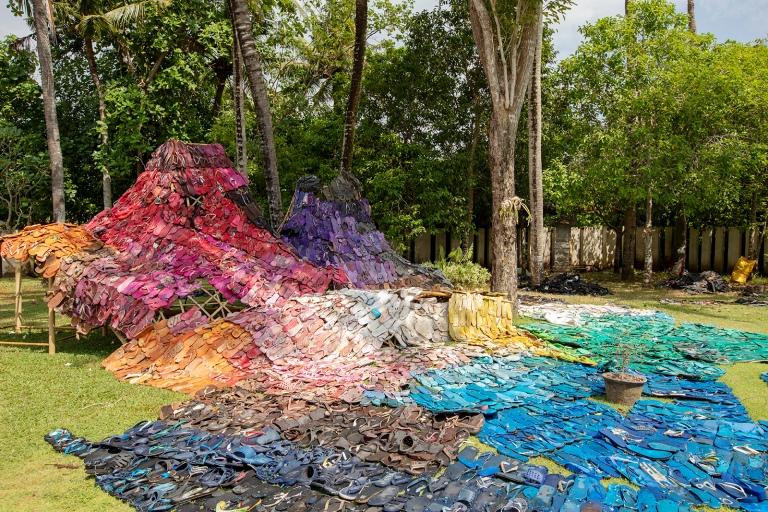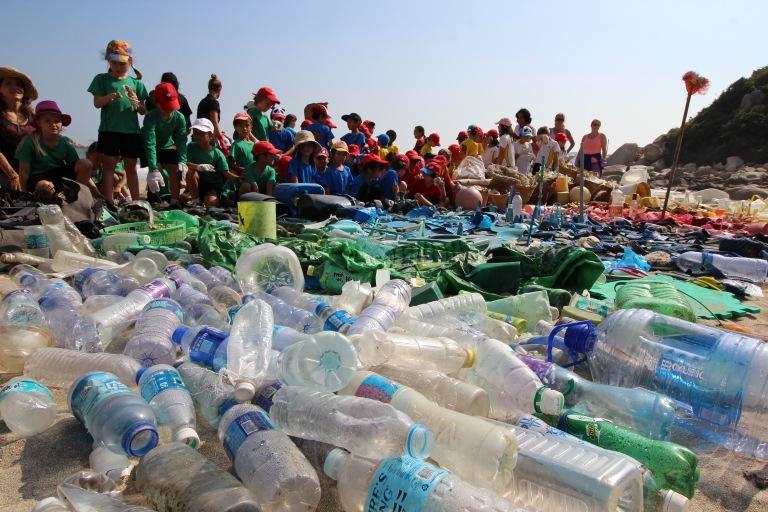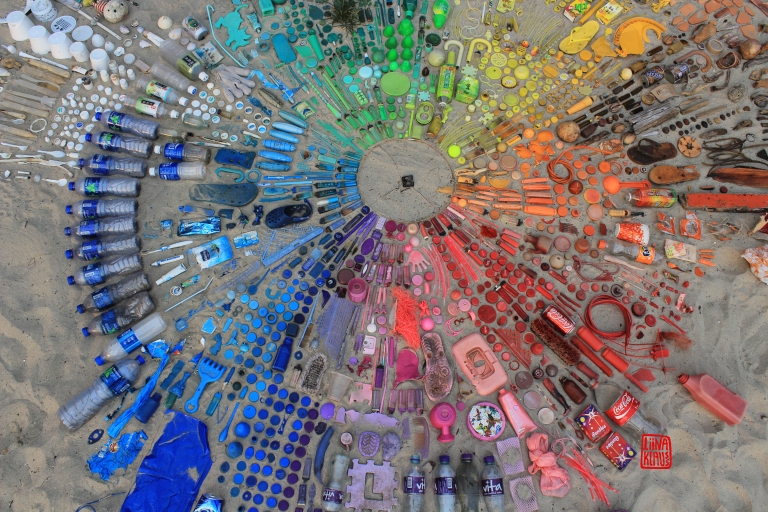Liina Klauss creates art installations with the purpose of raising awareness of the environmental crisis caused by plastic pollution. I was recently a part of one of her ‘curating the beach‘ events in Bali, and I can assure you: it is effectual! Facing the immense plastic pollution on a remote beach in a tropical paradise by collecting, touching and sorting mountains of flipflops, plastic bottles, toothpaste tubes, shampoo containers, tooth brushes etc. – and then turning all the ugliness into something beautiful is a hands-on experience of being able to make a difference.
With this interview with Bali-based German artist Liina Klauss I initiate a new series of talks with environmental changemakers at The Immaterialist.

In the following, Liina discusses sustainability, consumerism, the power of thoughts, environmental challenges, and art.
I recommend reading every word, as I am blown away by her insightful, visionary thoughts.
***
What does sustainability mean to you?
Sustainability in nature is the cycle of nourishing all of life through constant change. Sustainability inherently means change, and change includes birth and death. Life can only manifest through creation and destruction.
The sustainability discussion today revolves mainly about the aspects of maintaining, about keeping things as they are. We are in a phase of sustained stagnation which we refer to as “sustainability”. We want to keep everything as it is: our comforts, securities, our take-away coffees and our airplane flights. We do not want to change the status-quo. We conveniently want to make consumerism/capitalism “sustainable”. Shopping our way to sustainability is not possible.
Deep down we know there is something fundamentally wrong. The system is wrong. Buying carbon off-set miles, consuming green products and using bio-plastic straws are just a patch for a wound that is much bigger, much deeper. A wound that is systemic, a wound that is not only on the outside, but is our own wound.

I do not know how a truly sustainable life can look like in the modern age. We know how it looked like for indigenous people. Or at least we think we know. Their wisdom is almost lost. Our achievements in modern technology, medicine and science have been extraordinary.
Is there a way to combine both?
Wisdom of a harmonious relationship with nature, ourselves and sentient beings combined with the innovations of modern communications, medicine, and education extended on a global scale?
It could be amazing. And it could be sustainable. How far do we dare to dream?
“The present convergence of crises – in money, energy, education, health, water, soil, climate, politics, the environment, and more – is a birth crisis, expelling us from the old world into a new.” Charles Eisenstein
I feel that the birth crisis is an inner crisis that is mirrored on the outside. The crisis calls into question our old value system. We will need to be brutally honest with ourselves and our old ways and old goals. Do we still want what we used to want? Is it worth it? What does the world we want to live in look like? Do we want it to be sustainable? Sustainable for whom? For humans only? Or do we include sentient beings, animate and inanimate, rainforests and oceans, or the planet as a whole?
We need to be very clear on this, because we will create it. Thoughts are powerful. They are the seeds of what the future will look like.
***
How would you describe your art?
My art is not about pretty colours and rainbows. That is just the bait. You can only fully understand it when you participate in making it. You have to touch, feel, let yourself be touched.
These events are called ‘curating the beach’: physically showing up on a polluted beach, facing the man-made apocalypse, acknowledging our ignorance and destruction of nature and then doing something about it.
You will get dirty, sweaty and dig deep into the shadows of our throw-away society and consumerist culture. Yes, it is uncomfortable, disgusting and you might feel helpless, angry, you might start blaming others or yourself. Yet the presence of nature, of wild untamed nature, will transform the experience. Slowly these negative emotions change into curiosity, creativity and a sense of empowerment, sometimes even peace.
There is something in the process of facing and touching the dark sides of humanity and showing up vulnerable and innocent, of using your own hands and not looking away, that triggers healing and a deep connection, inside as well as outside.

I would rather describe my work as an ‘experience’ than a finished art piece. It is more like an inner creation than an outer one. I’m not even the artist. I’m only throwing you into unknown territory, exposing you to an untamed landscape, a wild and immersive experience of nature, changing your perspective from default to innocence and awe. The rest of the work is yours.
***
What do you view as the biggest environmental problem?
The interconnectedness, scale and complexity of environmental problems today makes it impossible to know which is the worst one. We tend to look from a perception of extinguishing fires.
Could we try not to look at the symptoms, but at the cause that created the symptom in the first place? I would like to try that in a little excursus here.
Are you with me that human thought is the starting point of every’thing’ we create? The smallest common denominator of any creation is thought. Everything has been a thought in someone’s mind before it became a thing in physical existence. Thought is the smallest unit of creativity.
As humans we have gotten into the habit of thinking in terms of ‘not enough’. The reasons might be evolutionary, they might be in our DNA or simply a mind-set that we can’t control. Whatever the reason, our society has an undertone of human life needing to be improved, an undertone of existence needing to be ‘easier, faster, richer, sweeter’. Dissatisfaction is the motivation making you buy more things, consume more services, work harder, and book more holidays.
This mindset fuels consumerist culture but has reached its physical limits. And also metaphysically: even though we have every’thing’ we are still not satisfied. We convince ourselves that ‘goods’ can satisfy our craving for a meaningful, connected and healthy life.

Most of us would agree that capitalism and its throw-away culture has a high price on resources, fellow living-beings and the planet as a whole. But it also has a high price on human sanity.
In a monetised culture we might be rich, but we are poor in connection to nature, to other humans and to spirit. We have forgotten the stories of the elders, forgotten how to walk barefoot in the woods, how to read the flight of the birds and how to celebrate community, how to connect to spirit.
“We are shaped by our thoughts; we become what we think. When the mind is pure, joy follows like a shadow that never leaves.” Gautama Buddha
We are only slowly waking up to the reality that what we want does not come neatly packaged over the counter and that money is not part of the equation. We are slowly waking up to the possibility that we might have to start looking inside for the solutions. And what a wake-up call it is!
In that sense I would say the human mind is the biggest environmental problem. And, even though it sounds illogical, the human mind will be the solution.
***
What are you currently working on?
I am currently working on a very exciting data visualisation project with marine scientist Skye Morét from the U.S. and data visualisation guru Moritz Stefaner from Germany. We have been chosen as finalists for National Geographic’s Plastic Challenge and are hoping to win and make it into the magazine.
At the same time I’m working on a book called “Involuntary Pairs” which is comprised of more than 500 found objects all collected on beaches in South-East Asia over the past 5 years. The objects look identical, yet one is man-made plastic, the other is natural. The pairs examine the merging of culture and nature to a point of inseparability. It’s very scary and beautiful at the same time.
And then there’s a new project with Potato Head in Bali which involves 10.000 salvaged flip-flops. I can’t tell you more. You will have to come to the opening of the new Desa Potato Head in March 2020.

Kære Dinne Spændende interview og særdeles velskrevet. Hun er helt sikkert et interessant bekendtskab for dig. Også godt med de små citater undervejs. Desværre og heldigvis afspejler interviewet, at der ikke er nogen nemme løsninger. Det er meget komplekst og derfor godt, at hun ikke serverer en patentløsning. Men det giver stof til eftertanke. Umiddelbart ville jeg jo mene, at velstand og uddannelse er vejen frem, men det indebærer øget produktion (og forurening) – men vil dæmpe måske det allerstørste problem: befolkningseksplosionen! UHA det er svært. Men godt at sætte fokus på!! Kh far
Sendt fra min iPad
> Den 5. nov. 2019 kl. 04.45 skrev The Immaterialist : > > >
LikeLike
Kære far, Ja, det er komplekst! Helt enig i at uddannelse og velstand (eller måske rettere velfærd) er vejen frem; men det behøver vel ikke betyde øget produktion? Måske blot en anden form for produktion…? Jeg tror at vi skal re-tænke måden der produceres på (og ikke mindst hvad der produceres). En anden kæmpe stopklods er dog at mange (ikke mindst på regeringsplan) modarbejder forandring i kapitalismens navn… Kh Dinne
LikeLike